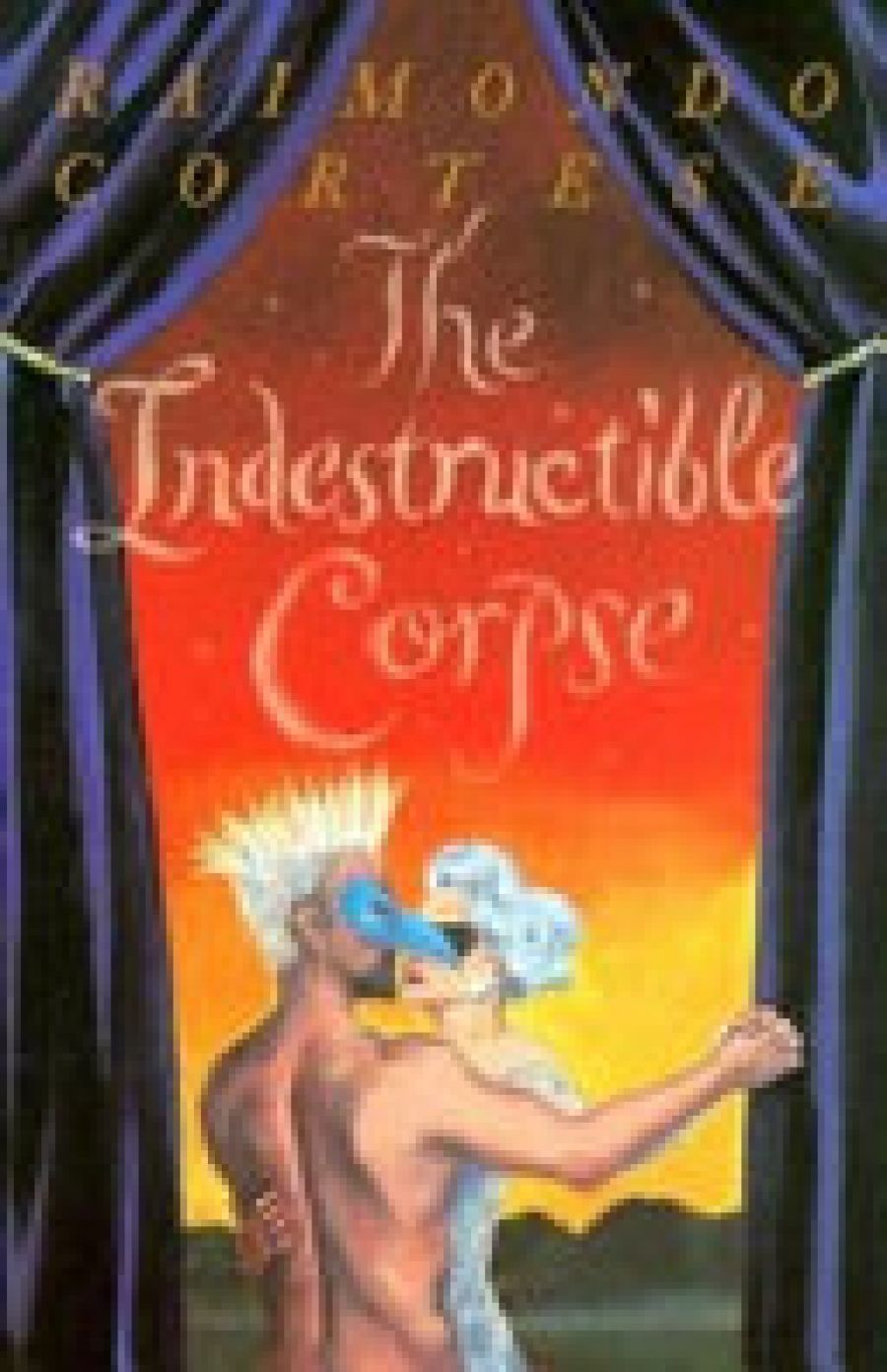
- Free Article: No
- Contents Category: Short Stories
- Review Article: Yes
- Online Only: No
- Custom Highlight Text:
Raimondo Cortese’s debut collection of stories, The Indestructible Corpse, contains ‘amazing stories’ in the true sense of the term, in that they produce amazement. The definitions of amazement in the Macquarie Dictionary include ‘overwhelming surprise or astonishment’; ‘stupefaction’; ‘perplexity’; and’ consternation’. Many of the stories are also maze-like, ‘a confusing network of intercommunicating paths or passages’; ‘a labyrinth’; ‘a state of bewilderment or confusion’.
- Book 1 Title: The Indestructible Corpse
- Book 1 Biblio: Text Publishing, $16.95 pb, 212 pp
The stories revel in the strangeness of the exotic. They roam far and wide through the history and pre-history of humankind, and of the earth itself, and cover the length and breadth of the globe, not to mention a brief trip to heaven. Their characters include ambassadors, knights, farmers, detectives, preachers, soldiers, sorceresses, explorers, actors, angels, pirates and nuns. They involve journeys into impossibly alien, strange lands, descriptions of the evolution of unheard-of creatures, adventures with mysterious beings, simulated wars and bizarre rituals in which death and life become interchangeable. They contain grand adventures, impenetrable mysteries, dangerous journeys, wars, romances, myths and legends, horror, hallucination, madness, magic, ritual, superstition and deceit.
The way in which Cortese’s stories catalogue the strange and the paradoxical has echoes of Italo Calvino and Jorge Luis Borges. Cortese delights in adding detail to dizzying details, creating a vertiginous world in which anything and everything is possible and appearances can never be trusted. His prose is full of highly sensuous description.
Some of the scenarios are so outrageous in their nuttiness they can only produce laughter. In ‘The Demolished Temple’, a nineteenth-century employee of a British pharmaceuticals company journeys to a village in Cambodia to report on opium yields. His attempts to interpret the symbols on limestone blocks, which may be the remains of an ancient temple and which are placed seemingly randomly throughout the village, are fruitless. The lives of the inscrutable residents of the village seem to be made up of a series of bizarre, formalised, even mathematical rituals, as if they were guided by an ‘invisible hand’:
They always ate quickly, and with their left hand. They wiped their faces in three slow circular motions, using an orange cloth that they hung on a hook above the table. Bread was broken by knocking it once on the left side of the head.
And:
Everybody laughed at me when I began to eat, probably because I insisted on using a fork. ‘When the meal was concluded they bowed three times and moved to an adjacent room, where they proceeded to hop about in a circle. I believe this was to promote digestion.
This almost Pythonesque humour is also evident in ‘A Dispatch for the Great Khan’, in which a hapless ambassador to an oriental city named Quazwir describes the even more bizarre customs which make up its citizens’ lives, including the grafting of body parts and the insertion of fragments of objects into their bodies. In fact, the swapping of bodily parts is so rife that it is almost impossible to know to whom one is speaking. ‘I regularly see Quazwirans conversing with a kneecap or a buttock.’ Their language is equally puzzling: ‘My interpreter often takes twenty minutes to translate a single word to Quazwiran. This naturally leaves me with little choice but to confine all talk to the bare essentials.’
Other stories, such as ‘The Indestructible Corpse’ and ‘The Affable Cannibal’, take perversity to extremes, overwhelming the reader with bizarre, horrific, yet also strangely beautiful, visions. There are also quieter, more reflective, and even gentle, whimsical moments in the stories, but even these are mixed with darkness.
Like Borges, Cortese uses the titles of apocryphal academic texts and authors in a way which suggests parody. He seems to see the gaining of knowledge -in particular scientific knowledge-as a pursuit fraught with difficulties. Whether this is simply a device for his fiction or whether it is derived from a belief in the labyrinthine, contorted nature of truth, I don’t know, but attempts by Cortese’s heroes to find truth, or even a stable, constant, knowable reality are constantly undermined. Identity, form and reality are built on shifting sands, with the potential to metamorphise into something else at an instant. All that remains is a series of theories, hypotheses, versions. Or if truth does appear, it appears in the most unexpected, seemingly impossible way. Language itself, and the various forms of signification, seem actually to prevent stable meaning rather than produce it.
It is the prerogative of the fiction writer – and perhaps even his vocation – to prefer stories to facts, but here narrative and narration seem actually to get in the way of attempts to gain knowledge. What is left is a childlike wonder at the strangeness of the world and a celebration of the capacities of the imagination. If these stories are ‘a-maze-ing’, they are also ‘wonder-full’.


Comments powered by CComment